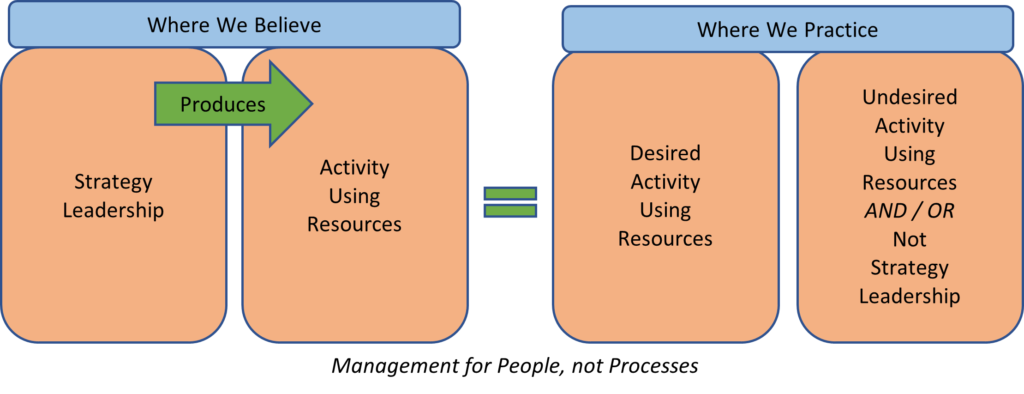Tools for Organization

Connect with me
‘From the Abundance of the Heart, Speaks the Mouth’
Regarding the graphic, ‘Out of Strategy and Leadership, Resources facilitate Activity’. In mathematics it is possible to see all results of the ‘If -Then’ formula. I break it down into 3 resulting areas and I use this formula to perform root cause analysis and to orderly develop strategy process.
This page addresses the ‘Mouth’ part of the formula. The Mouth is a tool, or medium, in which words are spoken. Beliefs cause actions and those actions need tools to be realized. This is the last look I consider because it is, in a sense, the least important, though absolutely critical. I cannot communicate without some sort of tool. However, that tool could be my vocal cords, a stick and some dirt, or a myriad of other ways to get a message across.
Tools are constantly being introduced and evolved. Especially in business. The best way to use technology, as stated by Jim Collins in his book, Good to Great, is as “an accelerator of momentum rather than a creator of it.” I believe all tools can be summarized in the same way. Tools accelerate momentum, they do not create it.
To reinforce my formula, ‘From the Abundance of the Heart, Speaks the Mouth’, when there are ‘Speaking’ issues, definitely look at the tools to be sure they are working properly and updated as much as possible. However, they are not the cause of most problems nor are they always the door to desired opportunity. The ‘Speaking’ issues are nearly all related to the Abundance of the Heart (Strategy and Leading). Getting new software usually does not solve people issues. It can solve acceleration and tool issues though. Professional speakers use tongue twister exercises to keep their mouth flexible and speaking is clearer. Improving tools does help!
… the Mouth …

My Personal Toolkit
As General Manager, Sales Manager, Customer Service in the service industry and volunteer work in the church, I have used many tools. The bigger an organization gets, the more important it is to have tools and that people use them for effective communication.
I primarily use a PC with Microsoft, but often use an Apple Macbook Pro. For project planning I love using Gantt charts. SMART goals keep my activities meaningful, relevant, and growth oriented. Specific software I am good at or have used is Microsoft Office (Especially Excel), Google Docs, ‘R’ Programming, SQL, Salesforce, Zoho, Facebook Business, Google Analytics, MailChimp, Hootsuite, and Music Software related to Podcasting.
These tools have calendars for personal and share use. Use them for meetings, tasks, collaboration. Use tools for data collection and reporting the data. Dashboards are necessary and customizable for different stakeholders. Map out the strategy and keep track of goals and how things are going. Get metrics on a good tool and use it!
Budgets are important financial management tools but can also be reflections and metrics of what is going on with people. Financial reviews provide much more than simple profit and loss.

Training
Be sure of this, people desire to be trained regularly! They want confidence in knowing what they are doing is right and appreciated! Training is a type of recognition of people and their gifts. Who is responsible for this in your organization? Is there training to incorporate more trainers? Not only do people take greater ownership and pride when they train, they remember more too!
Don’t forget that leaders need regular training too.
Does everyone have the same learning style? No. This is important to consider when learning and teaching. Many styles rely on simple lecture, but there are at least 7 unique styles, maybe more, that have been identified in how a person learns. Auditory and musical, visual and spatial, verbal, logical and mathematical, physical or kinesthetic, social and interpersonal, and solitary and intrapersonal. Using different styles reaches different people.
Recognition
People need to know they matter. When do your recognize your people, including volunteers? When do you recognize the leadership? It is important to remember that not everyone will ask questions and feel free to speak up when there are questions or concerns. This needs to be a proactive conversation from a leader. Every participant in every area needs follow up. Everyone needs recognition and thanks, even when they’re paid.
Roadmaps for Activity
Roadmaps, even on mobile devices, tell a person how to get from point A to point B. Goals that are not written down are just wishes, Fitzhugh Dodson. Goal setting was researched by a Harvard Business Study. Of total respondents, 83% had no goals. 14% had plans but had not written them down and were ten times more likely to succeed than those without any goals. 3% wrote down their goals and were three times more likely to succeed than the group who had some plan in mind. This is observable science and God given revelation. Get a roadmap!
Tools and Resources
How will people in every group and hierarchy level receive information and resources. Will there be a newsletter? Email, phone call, group text? What is distributed, how is it distributed, and who ensures that it has been? This includes people resources as well. Who needs help and what kind of help? What serve needs and upcoming events are on the way for people involvement? What are the appropriate channels?
Who is maintaining the non-people resources; books, videos, lesson material, etc.?
Lifecycle Growth
Every living thing, even some non-living things, have a lifecycle people general break down into 4 segments. New, Growth, Maturity, Decline. People are like this. What is your process to lead new people into growth, growing people into maturity, and the innovative ways to keep people from ‘dying’? Every stage has new challenges and requires different tactics. They are ‘on purpose’ plans to keep people in a healthy part of the lifecycle. If not, they decline. In business, employees are lost or become apathetic, in ministry, people become self-serving and apathetic.

How will each group from the smallest to those in the elder hierarchy be accountable and grown? How will each group be supported?
Outreach (Evangelism)
How are local groups outside the organization handled? Who are they, who is making contact, who is liaising with them in outreach? There are local, city, and global opportunities to not only help people and partner with. Who is training the outreach team? What are the proper channels and do people know who to refer those who need help to?
Wrap Up
Strategy is all about the interconnectivity of beliefs to action customized for various forms of organisms.
Step 1: ‘The Abundance’ = Vision, Mission, Values
Step 2: ‘The Heart, Speaks‘ = Actual VS Ideal
Step 3: ‘The Mouth’ = The Tools
This is Jeremy’s passion; these are Jeremy’s strengths. People are Jeremy’s motivation.